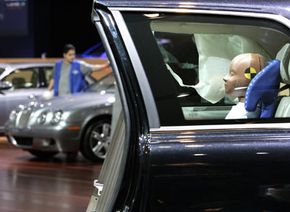In the 2007 Quentin Tarantino movie "Death Proof," a maniacal driver named Stuntman Mike boasts that his 1970 Chevrolet Nova is exactly what the film's title suggests: It's death-proof. In the hands of a safety-conscious driver, this would be a good thing. But Stuntman Mike isn't all that concerned with safety -- not his passengers' or any hapless people who cross his path.
Mike has outfitted the driver's side of his car with a cage and five-point seat belt to ensure his own survival when he hits other cars at high speeds. This is a good precaution on Stuntman Mike's part because he enjoys doing just that -- with gory results.
Advertisement
While the movie is fictitious, it does raise the question: Could a car really be death-proof? Would it be like Stuntman Mike's Nova, reinforced with steel beams and shatter-proof glass? That likely wouldn't be the case. Instead, what's ahead in the future of car safety -- including what may eventually emerge as a death-proof car -- is more in line with technological ingenuity than old-fashioned brute strength.
The best way to survive a car accident is to avoid it. So auto engineers are hard at work coming up with cars that protect passengers not so much by reinforced steel cages (although most vehicles have those, too), but rather with technology that helps drivers avoid collisions altogether.
Stuntman Mike's Chevy Nova is pretty cool. But the death-proof cars of the future will probably look a lot more like high-end Volvos, BMWs and Lexuses than a classic Detroit muscle car. And Volvo may be up first. As a working member of the PReVENT safety research group, the car manufacturer has promised an injury-proof car by 2020 [source: Reuters]. Those who can afford the luxury cars will benefit first; it'll take some time for these cutting-edge safety features to make their way into economy cars.
Many of the features that will comprise accident prevention systems in the future already exist. The challenge will be tying these components together.
Why will these systems be able to handle accidents better than a car's driver? Find out on the next page.
Advertisement


